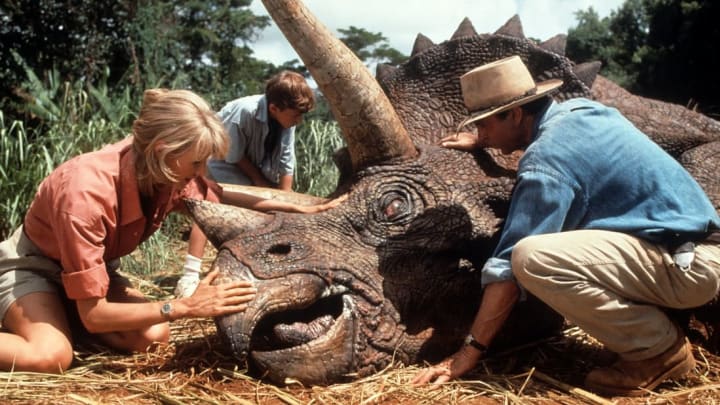by Alex Carter
In the 24 years that have passed since the original Jurassic Park hit theaters, what we know about dinosaurs has changed—a lot. Here's some of the new research that may change how you imagine these ancient animals, along with illustrations of what the animals may have looked like when they actually roamed the Earth.
1. VELOCIRAPTOR
Movie:

Reality:

A far cry from the large and vicious hunters of the Jurassic Park movies, velociraptors were in fact small and covered in feathers. More like vicious turkeys, if you will. The dinosaur in the movies was based on the Deinonychus, a much larger species whose name, appropriately, means “terrible claw.” (Even Deinonychus wasn't quite as big as the raptors portrayed in the movie.) That said, other large raptors have since been discovered, including the entire genus Utahraptor. (Its discoverers originally considered naming the type species Utahraptor spielbergi in hopes that the director would finance their research, but the name-for-funds deal never went through, so it was ultimately called Utahraptor ostrommaysorum.)
2. TYRANNOSAURUS REX
Movie:

Reality:

Large. Imposing. Fluffy? Apparently, the T. rex looked much, much stranger than the beast brought to life on the silver screen. Its face might have been covered with patches of armored skin and large scales, its eyes were placed much farther forward than other dinosaurs, and it carried itself rather horizontally, not upright, as most people still imagine it. It's thought from discoveries in close relatives that T. rex was covered in some feathers for a part of its life (especially as a juvenile, as seen in The Lost World), although the details remain hotly debated. Also debated are what it used its arms for: Hypotheses have ranged from a role in reproduction to lifting itself up (which is increasingly considered unlikely) to nothing at all.
3. COMPSOGNATHUS
Movie:

Reality:

This dinosaur was actually bigger in real life, although not by much. The smaller version depicted in the movies was based on what is now believed to be a young (and therefore small) Compsognathus. While many dinosaurs of its type were covered in feathers, there has been a notable lack of evidence about whether compies, as they're known, had feathers or scales. Most artists tend to draw simple proto-feathers, though; the result is an animal that looks more furry than feathery—and remarkably like a stretched rat.
4. TRICERATOPS
Movie:

Reality:

These creatures are generally portrayed as leathery and pointy—a bit like a rhinoceros designed by committee. The reality is somewhat stranger: They actually resembled porcupines. Some paleontologists believe that several nipple-shaped protrusions in their skin suggest where bristles would have been. In other areas, their skin was likely scaled rather than leathery. Their horns are another mystery. A 2009 study indicated that they were used largely for combat with other Triceratops, but they probably had a role in courtship as well.
5. BRACHIOSAURUS
Movie:

Reality:

In Jurassic Park, the Brachiosaurus is the first dinosaur seen after everyone arrives on the island, memorably rearing up to get at some particularly delicious leafage. But that behavior is now considered unlikely. The book Biology of the Sauropod Dinosaurs attempted to calculate if Brachiosaurs were able to rear on their hind legs and concluded, “Brachiosaurus would have expended considerably more energy [than a Diplodocus], could not have attained a stable upright pose, and would have risked serious injury to its forefeet when descending too rapidly.” Dr. Heinrich Mallison noted that it “was probably unlikely to use a bipedal … posture regularly and for an extended period of time. Although this dinosaur certainly could have reared up, for example during mating, this was probably a rare and short-lived event.”
6. SPINOSAURUS
Movie:

Reality:

The Spinosaurus was discovered only a few years after the Tyrannosaurus, but it never attracted fans in quite the same way. The fossils were destroyed in World War II during an Allied bombing raid on Munich, and the dinosaur became largely forgotten. However, Jurassic Park III resurrected the dinosaur's fame with a showdown that saw the Spinosaurus kill a Tyrannosaurus. Many fans cried foul, and the size of the Spinosaurus was indeed a mistake … in reality, it was much bigger.
It would have been up to three times heavier and 20 feet longer; a creature on the higher end of that range would have been bigger than even Jurassic World's (invented) I. rex. But could Spinosaurus have taken on a T. rex and lived? Almost certainly not. While physically bigger and armed with a bigger jaw, it was much less powerful, as most paleontologists now believe Spinosaurus used its long jaws for fishing. It actually lived mostly in the water.
